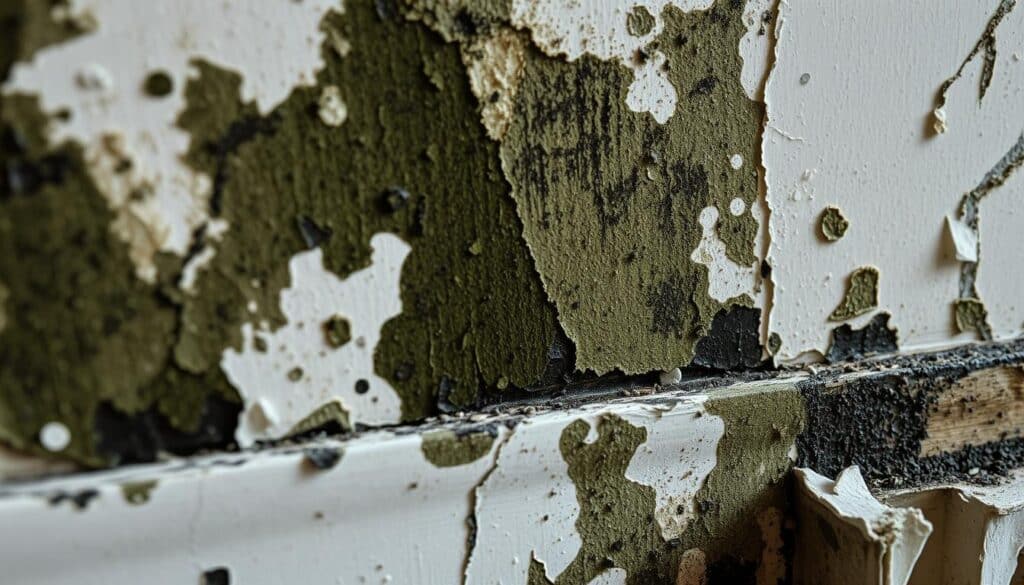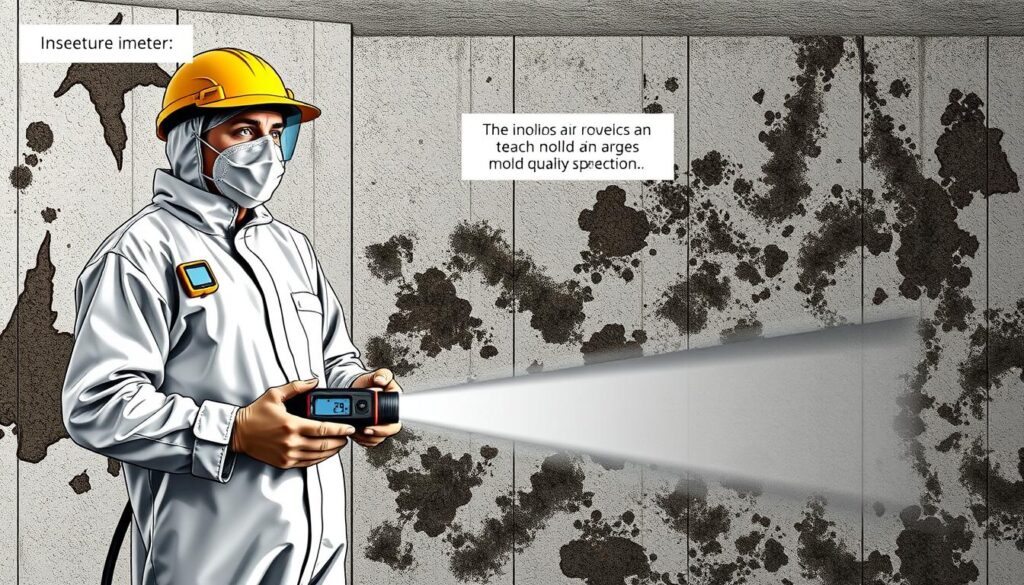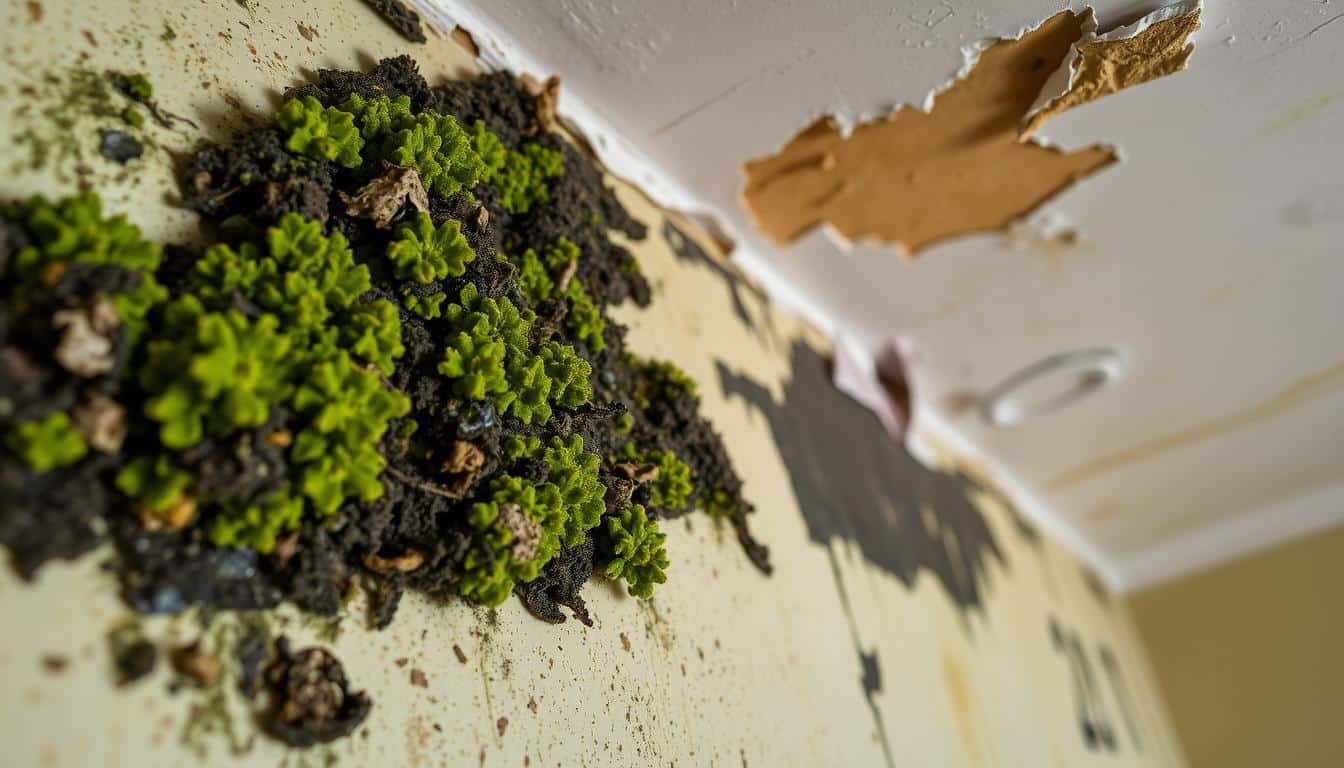Did you know mold can grow in your home in just 24 to 48 hours after water damage? This shows how fast you need to act to stop mold and keep your air clean. I’ve learned that fighting mold from water damage is a big challenge.
Water damage can happen without warning, making your home a mold haven. It could be a burst pipe, a leaky roof, or a flooded basement. Mold not only harms your home but also your health. So, knowing how to handle mold from water damage is very important.
Quick action is essential for water damage restoration. The first 48 hours are critical to stop mold. By removing water and drying areas fast, you can lower mold risk. But what if you’re too late? Don’t worry, I’ll share tips on identifying, removing, and preventing mold after water damage.
Key Takeaways
- Mold can start growing within 24-48 hours after water damage
- Prompt water removal and drying are crucial for preventing mold growth
- Common mold types in water-damaged homes include Aspergillus and Cladosporium
- Mold exposure can cause health issues from allergies to severe respiratory problems
- Professional mold testing is recommended for accurate detection
- Mold growth can significantly impact property value
- Regular maintenance and timely repairs can reduce water damage risk
Understanding Mold and Water Damage
I’ve seen how water damage can quickly lead to mold in homes. It’s a serious issue that needs quick action for mold remediation and moisture control. Let’s explore the main points of this problem.
What Causes Mold Growth After Water Damage
Mold loves damp places, and water damage is perfect for it. It can start growing in just 24 to 48 hours on wet surfaces. Even small leaks or flooding can cause mold to spread in a home.
Common Types of Mold in Water-Damaged Homes
Several types of mold can infest homes with water damage. The most common include:
- Aspergillus
- Cladosporium
- Stachybotrys Chartarum (black mold)
These molds can grow on many surfaces, like wood, drywall, tiles, and fabrics. Professional mold inspectors use special tests to find out what types are in a home.
Health Risks Associated with Mold Exposure
Mold exposure can cause many health problems. Kids living in moldy homes are five times more likely to get asthma. Other symptoms include:
- Sneezing and runny nose
- Red eyes and skin rashes
- Coughing and respiratory issues
- Headaches and memory loss
Because of these risks, it’s important to fix water damage fast and get proper mold remediation. Getting professional help is often needed to control moisture and stop mold from coming back.
Identifying Signs of Mold from Water Damage
Water damage can quickly turn into mold in homes. Spotting mold early is key to avoid damage and health risks. Here are the signs that mean it’s time for a mold check or flood cleanup.

Look for discoloration on walls, ceilings, or floors, especially where water has been. Mold can be green, black, brown, or white. It can grow in just 24 to 48 hours, so act fast.
A musty smell is another sign. If your home smells like damp earth, especially in basements or bathrooms, check for mold. These smells often mean mold is hiding behind walls or under floors.
- Visible patches of fuzzy or slimy growth
- Peeling wallpaper or bubbling paint
- Warped wood or drywall
- Increased allergy symptoms indoors
Health issues can also hint at mold. If you or your family has allergies, coughs, or headaches at home, mold might be the cause. Almost five million people in the U.S. have asthma from mold, showing how urgent mold checks are.
If you’re unsure, trust your gut and call experts. A detailed mold check can find hidden growth and solve the problem before it gets worse. Fixing mold early keeps your health safe and your home’s value high.
The Importance of Quick Action in Preventing Mold Growth
Time is crucial when dealing with water damage. Acting fast is key to stop mold and protect your home.
The 24-48 Hour Window for Effective Water Removal
Mold can grow in just 24 hours after water damage. It’s vital to start removing water right away. I suggest calling experts in dehumidification services within this time to dry everything properly.
Reducing Humidity and Maintaining a Dry Environment
Keeping the area dry after water removal is essential. I use powerful dehumidifiers and fans to lower humidity fast. This step stops mold and prevents more damage to your home’s structure.
Using Mold-Resistant Materials in Renovation
When renovating after water damage, choose mold-resistant materials. I recommend using paperless drywall and mold-resistant paint. These materials help block mold, giving you peace of mind and possibly increasing your home’s value.
Quick action in water damage repair can save homeowners thousands in the long run and protect their property value.
Fixing water damage quickly does more than solve the immediate problem. It also protects your home’s future. Don’t wait to get professional help for water damage repair and dehumidification services.
Professional vs. DIY Mold Testing Methods
Choosing between professional and DIY mold testing can be hard. Both have good points for checking for mold and keeping air clean indoors. Let’s look at the good and bad of each.

Professional mold testing gives a full check of your home. Experts do detailed checks, measure moisture, and test air quality. This way, you get exact results and a clear plan to fix mold problems. But, it might cost a lot, from $200 to $800 an hour, based on the job’s complexity.
DIY mold test kits, however, are cheaper, costing $50 to $100 per room. They’re quick and easy to use, great for first checks. But, they only check for mold spores in the air and might miss other mold issues.
| Testing Method | Cost | Accuracy | Scope |
|---|---|---|---|
| Professional | $200-$800/hour | High | Comprehensive |
| DIY Kit | $50-$100/room | Limited | Airborne spores only |
When picking a method, think about your mold problem’s size, your budget, and your family’s health. For small issues, a DIY kit might work. But for big mold problems or past water damage, getting a pro is safer for a full fix and better air quality.
Effective Mold Remediation Techniques
Dealing with mold can feel overwhelming. That’s why I’m here to help you with effective mold remediation techniques. When you face water damage, acting fast is crucial. It helps prevent mold growth and keeps your home safe.
Safety Precautions During Mold Removal
Safety is the top priority in mold remediation. Always wear protective gear like gloves, goggles, and masks. This gear protects you from harmful spores and chemicals used in cleaning.
Cleaning Methods for Different Surfaces
For hard surfaces, a soap and water mix or a bleach solution works well. Mix 1 cup of household bleach with 1 gallon of water for a strong cleaning solution. On non-porous surfaces, a simple wipe-down with water and dish detergent is often enough.
| Surface Type | Cleaning Method |
|---|---|
| Hard Surfaces | Soap and water or bleach solution |
| Non-porous Surfaces | Water and dish detergent |
| Porous Materials | Professional cleaning or disposal |
When to Call in Professional Help
While you can handle small mold issues yourself, some cases need a pro. If you’re dealing with hazardous black mold or a big infestation, it’s time to call the experts. Professional mold remediation services have the right tools and know-how for a complete cleanup.
Remember, fixing the moisture problem is key to stopping mold from coming back. Keep your home well-ventilated and dry to make it hard for mold to grow. By using these techniques, you’ll be ready to face mold issues and keep your home safe from water damage.
Preventing Future Mold Growth After Water Damage
I’ve learned that mold prevention strategies are crucial after water damage. Quick action is key – mold can develop in just 24 to 48 hours. To protect your home, it’s essential to dry and clean waterlogged areas fast.
Effective moisture control is vital. I recommend using fans for air circulation to dry humid spots. For better results, especially in small rooms like bathrooms, a dehumidifier works wonders. These steps create an environment where mold can’t thrive.
Checking potential water leak points is another important step. Windows and doors should be sealed to prevent water intrusion. For long-term protection, consider installing new gutters and gutter guards. These measures can significantly reduce the risk of water damage and subsequent mold growth.
In cases of severe water damage, it’s wise to seek professional help. Water damage restoration services are crucial for preventing future mold growth. They not only clean up the immediate damage but also implement measures to kill mold spores and create an inhospitable environment for mold.
| Preventive Measure | Benefit |
|---|---|
| Quick drying (within 48 hours) | Prevents initial mold growth |
| Using fans and dehumidifiers | Controls moisture levels |
| Sealing leak points | Prevents water intrusion |
| Professional restoration services | Ensures thorough cleanup and prevention |
Remember, mold can grow anywhere, indoors or outdoors. By implementing these mold prevention strategies and maintaining proper moisture control, you can protect your home and health from the risks of mold after water damage.
The Impact of Mold on Property Value
Mold from water damage can really hurt a property’s value. I’ve seen homes lose up to 30% of their worth because of mold. It’s not just about looks; mold can also cause serious structural problems.
How mold affects home appraisals
When appraisers see mold, they get worried. Visible mold makes a home less attractive to buyers, which can lower offers. In extreme cases, mold has even made luxury properties lose over half their value.
Disclosure requirements for mold damage
Many states make sellers tell buyers about past mold issues. Being honest is important. If you hide mold problems, you could face legal issues and further decrease your property’s value.
Restoring property value after mold remediation
Acting fast is crucial to keep your property’s value. Professional remediation can help restore your home’s worth. After treatment, getting a new appraisal can show the property’s improved condition. Remember, fixing the water damage problem is key to prevent mold from coming back and protect your investment.
| Mold Impact | Potential Value Decrease |
|---|---|
| Minor visible mold | 5-10% |
| Extensive mold infestation | 20-30% |
| Structural damage from mold | 30-50% or more |
Insurance Coverage for Mold from Water Damage
Insurance for mold from water damage can be confusing. Most homeowner’s policies cover sudden, accidental water damage. This includes things like burst pipes or broken appliances. But, not all cases are covered.
Slow leaks and long-term moisture issues are often not covered. If you have a slow leak causing mold, you might have to pay for water damage restoration yourself. It’s important to fix water problems quickly to stop mold and avoid claim denials.
Policy limits for mold remediation vary. Some insurers cap coverage at $5,000, while others might offer up to $10,000. If you live in a high-risk area or worry about mold, you might want extra coverage.
| Coverage Type | Typical Policy Limit | Average Cost of Remediation |
|---|---|---|
| Standard Home Insurance | $1,000 – $10,000 | $2,235 |
| Additional Mold Coverage | Varies by policy | Depends on extent of damage |
If you have mold, document everything well. Take photos, keep records of talks with your insurance, and get mold remediation estimates. This info is key when filing a claim.
“Mold can start growing on damp surfaces within 24 hours, according to the Federal Emergency Management Agency.”
Prevention is the best way. Fixing water damage quickly can save you from expensive mold remediation later. If you’re unsure about your coverage, check your policy or talk to your insurance agent.
Essential Equipment for Dealing with Water Damage and Mold
Having the right tools is key when facing water damage and mold. The right equipment can save your home from major damage. Let’s look at some important items you’ll need to handle these issues.
Dehumidifiers and their role in moisture control
Dehumidifiers are crucial for controlling moisture and stopping mold. They draw humidity from the air, making it drier. To prevent mold, keep humidity between 30% and 50%.
High-quality dehumidifiers can get humidity down to 40%. For big or very humid areas, you might need industrial-grade dehumidifiers.
Air purifiers for improving indoor air quality
Air purifiers are key for better indoor air after water damage. They remove harmful particles and odors. Look for ones with HEPA filters, which catch particles as small as 0.3 microns.
This level of filtration is vital for removing mold spores and other contaminants during cleanup.
Protective gear for DIY mold removal
If you’re doing mold removal yourself, you need the right gear. This includes gloves, goggles, and masks or respirators. For bigger areas, wear a full protective suit.
Use air-purifying masks or reusable respirators for long work sessions. Remember, mold spores can be toxic, so always wear proper protection.
FAQ
What causes mold growth after water damage?
Mold and mildew are fungi that grow in damp places. They spread through the air. Water damage makes a perfect home for them by providing the moisture they need.
What are the common types of mold found in water-damaged homes?
In water-damaged homes, you might find Aspergillus, Cladosporium, and Stachybotrys chartarum (black mold). These are common types.
What are the health risks associated with mold exposure?
Mold exposure can cause allergic reactions and skin problems. It can also lead to serious breathing issues. Long-term exposure to some molds can cause brain problems and even death.
What are the signs of mold growth after water damage?
Look for discoloration, musty smells, and slimy patches. Sneezing, rashes, coughing, and headaches are signs of mold too.
Why is quick action important in preventing mold growth after water damage?
Acting fast within 24-48 hours is key. It helps remove water and dry the area, stopping mold. Use dehumidifiers and fans to lower humidity and speed up drying.
What are the advantages and disadvantages of professional vs. DIY mold testing?
Professional testing is reliable but costs more. It finds mold in hidden spots. DIY kits are cheaper but might miss some mold.
What safety precautions should be taken during mold removal?
Wear gloves, goggles, and masks when removing mold. Be careful and clean surfaces right.
How can I prevent future mold growth after water damage?
Keep moisture low by ventilating well. Use smart bathroom timers and humidity sensors. Clean mold quickly. Choose mold-resistant materials for renovations.
How does mold affect property value?
Mold lowers property value by making it look bad and hinting at structural problems. It scares off buyers and lowers appraisals. Fixing mold early keeps your property value up.
Is mold damage covered by homeowner’s insurance?
Insurance usually covers mold from sudden events but not wear and tear. Policy limits vary. You might need extra coverage.
What equipment is essential for dealing with water damage and mold?
Dehumidifiers control moisture and stop mold. Air purifiers clean the air by removing spores. For DIY, wear protective gear and use safe mold products.




